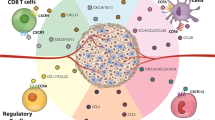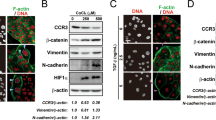Abstract
Chemokines and their receptors play important roles in various aspects of tumoral processes, and evidence was provided for their critical involvement in determining the metastatic destination of tumor cells. Here, we analyzed in vitro and in vivo, how CCR6 expression could alter the behavior of Lewis lung carcinoma (LLC) cells, which were shown to express low levels of the CCR6 ligand, CCL20 (LARC), both in vitro and in vivo. The expression of CCR6 significantly decreased the number of metastases in immunocompetent C57BL/6 mice, without affecting the tumor-forming ability of LLC cells. This was correlated with a decrease in clonogenicity in soft and hard agar, and with increased adhesion to type-IV collagen. These two observations made in basal conditions were enhanced when CCL20 was added to the assay medium. Thus, expression of CCR6 in tumor cells, associated with the local production of CCL20, decreased the metastatic potential of the LLC line. We propose a model, in which the expression of a chemokine receptor in tumor cells can act as a metastasis-suppressor, or a metastasis-promoting factor, according to the expression, or the absence of expression of the cognate ligand(s) in the tumor.
This is a preview of subscription content, access via your institution
Access options
Subscribe to this journal
Receive 12 print issues and online access
$259.00 per year
only $21.58 per issue
Buy this article
- Purchase on Springer Link
- Instant access to full article PDF
Prices may be subject to local taxes which are calculated during checkout





Similar content being viewed by others
Accession codes
References
Rossi D, Zlotnik A . The biology of chemokines and their receptors. Annu Rev Immunol 2000; 18: 217–242.
Murphy PM . International union of pharmacology. XXX. Update on chemokine receptor nomenclature. Pharmacol Rev 2002; 54: 227–229.
Olson TS, Ley K . Chemokines and chemokine receptors in leukocyte trafficking. Am J Physiol Regul Integr Comp Physiol 2002; 283: R7–R28.
Rollins BJ . Chemokines. Blood 1997; 90: 909–928.
Muller A, Homey B, Soto H, Ge N, Catron D, Buchanan ME et al. Involvement of chemokine receptors in breast cancer metastasis. Nature 2001; 410: 50–56.
Moore MA . The role of chemoattraction in cancer metastases. Bioessays 2001; 23: 674–676.
Murakami T, Cardones AR, Hwang ST . Chemokine receptors and melanoma metastasis. J Dermatol Sci 2004; 36: 71–78.
Schutyser E, Struyf S, Van Damme J . The CC chemokine CCL20 and its receptor CCR6. Cytokine Growth Factor Rev 2003; 14: 409–426.
Kleeff J, Kusama T, Rossi DL, Ishiwata T, Maruyama H, Friess H et al. Detection and localization of Mip-3alpha/CCL20/Exodus, a macrophage proinflammatory chemokine, and its CCR6 receptor in human pancreatic cancer. Int J Cancer 1999; 81: 650–657.
Kimura T, Takeshima H, Nomiyama N, Nishi T, Kino T, Kochi M et al. Expression of lymphocyte-specific chemokines in human malignant glioma: essential role of LARC in cellular immunity of malignant glioma. Int J Oncol 2002; 21: 707–715.
Abiko Y, Nishimura M, Kusano K, Nakashima K, Okumura K, Arakawa T et al. Expression of MIP-3alpha/CCL20, a macrophage inflammatory protein in oral squamous cell carcinoma. Arch Oral Biol 2003; 48: 171–175.
Rossi DL, Vicari AP, Franz-Bacon K, McClanahan TK, Zlotnik A . Identification through bioinformatics of two new macrophage proinflammatory human chemokines: MIP-3alpha and MIP-3beta. J Immunol 1997; 158: 1033–1036.
Schutyser E, Struyf S, Menten P, Lenaerts JP, Conings R, Put W et al. Regulated production and molecular diversity of human liver and activation-regulated chemokine/macrophage inflammatory protein-3 alpha from normal and transformed cells. J Immunol 2000; 165: 4470–4477.
Ghosh S, Spagnoli GC, Martin I, Ploegert S, Demougin P, Heberer M et al. Three-dimensional culture of melanoma cells profoundly affects gene expression profile: a high density oligonucleotide array study. J Cell Physiol 2005; 204: 522–531.
Kimsey TF, Campbell AS, Albo D, Wang TN . Co-localization of macrophage inflammatory protein-3alpha (Mip-3alpha) and its receptor, CCR6, promotes pancreatic cancer cell invasion. Cancer J 2004; 10: 374–380.
Wang J, Xi L, Hunt JL, Gooding W, Whiteside TL, Chen Z et al. Expression pattern of chemokine receptor 6 (CCR6) and CCR7 in squamous cell carcinoma of the head and neck identifies a novel metastatic phenotype. Cancer Res 2004; 64: 1861–1866.
Gemma A, Takenaka K, Hosoya Y, Matuda K, Seike M, Kurimoto F et al. Altered expression of several genes in highly metastatic subpopulations of a human pulmonary adenocarcinoma cell line. Eur J Cancer 2001; 37: 1554–1561.
Ghadjar P, Coupland SE, Na IK, Noutsias M, Letsch A, Stroux A et al. Chemokine receptor CCR6 expression level and liver metastases in colorectal cancer. J Clin Oncol 2006; 24: 1910–1916.
Rubie C, Oliveira V, Kempf K, Wagner M, Tilton B, Rau B et al. Involvement of chemokine receptor CCR6 in colorectal cancer metastasis. Tumour Biol 2006; 27: 166–174.
Dellacasagrande J, Schreurs OJ, Hofgaard PO, Omholt H, Steinsvoll S, Schenck K et al. Liver metastasis of cancer facilitated by chemokine receptor CCR6. Scand J Immunol 2003; 57: 534–544.
Crittenden M, Gough M, Harrington K, Olivier K, Thompson J, Vile RG . Expression of inflammatory chemokines combined with local tumor destruction enhances tumor regression and long-term immunity. Cancer Res 2003; 63: 5505–5512.
Bonnotte B, Crittenden M, Larmonier N, Gough M, Vile RG . MIP-3alpha transfection into a rodent tumor cell line increases intratumoral dendritic cell infiltration but enhances (facilitates) tumor growth and decreases immunogenicity. J Immunol 2004; 173: 4929–4935.
Furumoto K, Soares L, Engleman EG, Merad M . Induction of potent antitumor immunity by in situ targeting of intratumoral DCs. J Clin Invest 2004; 113: 774–783.
Mirjolet JF, Didelot C, Barberi-Heyob M, Merlin JL . G1/S but not G0/G1 cell fraction is related to 5-fluorouracil cytotoxicity. Cytometry 2002; 48: 6–13.
Li L, Price JE, Fan D, Zhang RD, Bucana CD, Fidler IJ . Correlation of growth capacity of human tumor cells in hard agarose with their in vivo proliferative capacity at specific metastatic sites. J Natl Cancer Inst 1989; 81: 1406–1412.
Saiga T, Ohbayashi T, Tabuchi K, Midorikawa O . A model for tumorigenicity and metastatic potential: growth in 1.0% agar cultures. In vitro Cell Dev Biol 1987; 23: 850–854.
Varona R, Zaballos A, Gutierrez J, Martin P, Roncal F, Albar JP et al. Molecular cloning, functional characterization and mRNA expression analysis of the murine chemokine receptor CCR6 and its specific ligand MIP-3alpha. FEBS Lett 1998; 440: 188–194.
Al-Aoukaty A, Rolstad B, Giaid A, Maghazachi AA . MIP-3alpha, MIP-3beta and fractalkine induce the locomotion and the mobilization of intracellular calcium, and activate the heterotrimeric G proteins in human natural killer cells. Immunology 1998; 95: 618–624.
Kiley SC, Clark KJ, Duddy SK, Welch DR, Jaken S . Increased protein kinase C delta in mammary tumor cells: relationship to transformation and metastatic progression. Oncogene 1999; 18: 6748–6757.
Heino J . The collagen receptor integrins have distinct ligand recognition and signaling functions. Matrix Biol 2000; 19: 319–323.
Campbell JJ, Hedrick J, Zlotnik A, Siani MA, Thompson DA, Butcher EC . Chemokines and the arrest of lymphocytes rolling under flow conditions. Science 1998; 279: 381–384.
Fitzhugh DJ, Naik S, Caughman SW, Hwang ST . C-C chemokine receptor 6 is essential for arrest of a subset of memory T cells on activated dermal microvascular endothelial cells under physiologic flow conditions in vitro. J Immunol 2000; 165: 6677–6681.
Meissner A, Zilles O, Varona R, Jozefowski K, Ritter U, Marquez G et al. CC chemokine ligand 20 partially controls adhesion of naive B cells to activated endothelial cells under shear stress. Blood 2003; 102: 2724–2727.
Liao F, Shirakawa AK, Foley JF, Rabin RL, Farber JM . Human B cells become highly responsive to macrophage-inflammatory protein-3 alpha/CC chemokine ligand-20 after cellular activation without changes in CCR6 expression or ligand binding. J Immunol 2002; 168: 4871–4880.
Annels NE, Da Costa CE, Prins FA, Willemze A, Hogendoorn PC, Egeler RM . Aberrant chemokine receptor expression and chemokine production by Langerhans cells underlies the pathogenesis of Langerhans cell histiocytosis. J Exp Med 2003; 197: 1385–1390.
Acknowledgements
This work was supported by the Belgian programme on Interuniversity Poles of attraction initiated by the Belgian State, Prime Minister's Office, Science Policy Programming, the Fédération Belge contre le Cancer, Fonds de la Recherche Scientifique Médicale of Belgium, Télévie, Actions de Recherche Concertées of the Communauté Française de Belgique, Centre de Recherche Inter-universitaire en Vaccinologie and LifeSciHealth program of the European Community (Grant LSHB-CT-2003-503337) to MP. AS is recipient of a fellowship from the Belgian Fonds pour la formation à la Recherche dans l'Industrie et l'Agriculture. The scientific responsibility is assumed by the authors.
Author information
Authors and Affiliations
Corresponding author
Rights and permissions
About this article
Cite this article
Sutherland, A., Mirjolet, JF., Maho, A. et al. Expression of the chemokine receptor CCR6 in the Lewis lung carcinoma (LLC) cell line reduces its metastatic potential in vivo. Cancer Gene Ther 14, 847–857 (2007). https://doi.org/10.1038/sj.cgt.7701074
Received:
Revised:
Accepted:
Published:
Issue Date:
DOI: https://doi.org/10.1038/sj.cgt.7701074
Keywords
This article is cited by
-
Panel of miR-150 and linc00673, regulators of CCR6/CCL20 may serve as non-invasive diagnostic marker of non-small cell lung cancer
Scientific Reports (2023)
-
Overexpression of CCL20 and its receptor CCR6 predicts poor clinical prognosis in human gliomas
Medical Oncology (2012)
-
Expression of the chemokine receptor CCR6 correlates with a favorable prognosis in patients with adenocarcinoma of the lung
Tumor Biology (2011)



